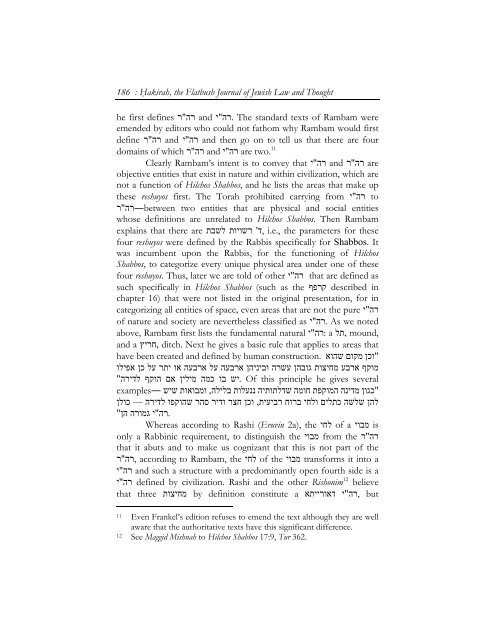King Solomon's Takanah: Rambam's Eruv - Hakirah.org
King Solomon's Takanah: Rambam's Eruv - Hakirah.org
King Solomon's Takanah: Rambam's Eruv - Hakirah.org
You also want an ePaper? Increase the reach of your titles
YUMPU automatically turns print PDFs into web optimized ePapers that Google loves.
הר<br />
186 : Hạkirah, the Flatbush Journal of Jewish Law and Thought<br />
he first defines "י . The standard texts of Rambam were<br />
emended by editors who could not fathom why Rambam would first<br />
define "י and then go on to tell us that there are four<br />
domains of which "י are two. 11<br />
Clearly Rambam’s intent is to convey that "ר are<br />
objective entities that exist in nature and within civilization, which are<br />
not a function of Hilchos Shabbos, and he lists the areas that make up<br />
these reshuyos first. The Torah prohibited carrying from רה "י to<br />
―between two entities that are physical and social entities "ר<br />
whose definitions are unrelated to Hilchos Shabbos. Then Rambam<br />
explains that there are רשויות לשבת ' , i.e., the parameters for these<br />
four reshuyos were defined by the Rabbis specifically for Shabbos. It<br />
was incumbent upon the Rabbis, for the functioning of Hilchos<br />
Shabbos, to categorize every unique physical area under one of these<br />
four reshuyos. Thus, later we are told of other רה "י that are defined as<br />
such specifically in Hilchos Shabbos (such as the קרפף described in<br />
chapter 16) that were not listed in the original presentation, for in<br />
רה categorizing all entities of space, even areas that are not the pure<br />
of nature and society are nevertheless classified as "י .רה As we noted<br />
above, Rambam first lists the fundamental natural "י :רה a ,תל mound,<br />
and a ,חריץ ditch. Next he gives a basic rule that applies to areas that<br />
have been created and defined by human construction. "<br />
"י<br />
רה and "י<br />
ד<br />
רה and רה "ר<br />
רה and רה "ר<br />
רה and רה "ר<br />
רה<br />
וכן מקום שהוא<br />
מוקף ארבע מחיצות גובהן עשרה וביניהן ארבעה על ארבעה או יתר על כן אפילו<br />
יש בו כמה מילין אם הוקף לדירה<br />
כגון מדינה המוקפת חומה שדלתותיה ננעלות בלילה, ומבואות שיש<br />
להן שלשה כתלים ולחי ברוח רביעית, וכן חצר ודיר סהר שהוקפו לדירה — כולן<br />
רה"י גמורה הן<br />
" . Of this principle he gives several<br />
examples― "<br />
" .<br />
Whereas according to Rashi (<strong>Eruv</strong>in 2a), the ל חי of a מבוי is<br />
רה from the מבו י only a Rabbinic requirement, to distinguish the<br />
that it abuts and to make us cognizant that this is not part of the<br />
transforms it into a מבוי of the לחי according to Rambam, the ,רה"ר<br />
and such a structure with a predominantly open fourth side is a "י<br />
defined by civilization. Rashi and the other Rishonim 12 believe "י<br />
that three מחיצות by definition constitute a<br />
, but<br />
"ר<br />
רה "י<br />
דאורייתא<br />
רה<br />
רה<br />
11 Even Frankel’s edition refuses to emend the text although they are well<br />
aware that the authoritative texts have this significant difference.<br />
12 See Maggid Mishnah to Hilchos Shabbos 17:9, Tur 362.
















